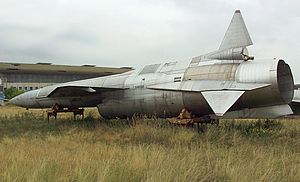Tupolev Tu-123
| Tu-123 Yastreb | |
|---|---|
 |
|
| Tu-123 at Khodynka Field, Moscow | |
| Role | Reconnaissance Drone |
| National origin | Soviet Union |
| Manufacturer | Tupolev |
| First flight | 1960 |
| Introduction | 1964 |
| Retired | 1979 |
| Status | out of service |
| Primary user | Soviet Union |
| Produced | 1964–1972 |
| Number built | 52 |
The Tupolev Tu-123 Yastreb (Falcon, Russian: Ястреб) was one of the earliest Soviet reconnaissance drones that began development in 1960. Sometimes referred to as the "DBR-1", it was introduced into active service in 1964.
The Tu-123 was a long-range, high-altitude supersonic strategic unmanned reconnaissance aircraft, in a form reminiscent of a big dart, conceptually somewhat similar to the United States' D-21. It carried both film cameras and SIGINT payloads.
The Tu-123 was ground-launched with JATO boosting and powered by a KR-15 afterburning turbojet in flight. The KR-15 was a lower-cost, short-life, expendable version of the R-15 engine used on the twin-engine, Mach 3-class Mikoyan-Gurevich MiG-25 Foxbat interceptor. The Tu-123 itself was expendable, parachuting its payload to the ground for recovery.
The Tu-123 was a development of the proposed Tupolev Tu-121 supersonic nuclear-armed cruise missile program. After the cancellation of that project in favor of ballistic missiles, the design was modified for a high-altitude reconnaissance role. The project was officially launched on 16 August 1960, under the designation “DBR-1” with the Tupolev Design Bureau designation of “I123K” (later changed to “Tu-123”). Factory testing was completed in September 1961 and flight tests by December 1963. The new UAV was adopted into active duty service on 23 May 1964. Mass production was assigned to Voronezh Factory Number 64, and from 1964–1972 a total of 52 units were manufactured.
...
Wikipedia
